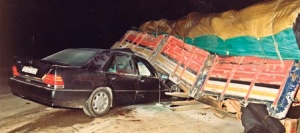Susurluk car crash
 | |
| Date | 3 November 1996 |
|---|---|
| Type | |
| Interest of | Sibel Edmonds |
| Description | The event which lead to the coining of the phrase 'deep state'. |
Contents
Background
Prior to the crash, all the victims, plus Turkish Interior Minister Mehmet Ağar, had been staying at the Onura Hotel in Kuşadası.[1] The assassination plan called for Ağar to be killed too. However, he was warned by Sami Hoştan so he remained at the hotel and told the rest to leave without him.[2]
Former MHP deputy Kubilay Uygun said that he was introduced to Abdullah Çatlı and Hüseyin Kocadağ three days before by a now-retired lieutenant general. Uygun says that he too has worked for the "deep state".[3]
The Prosecutor's Report said that the passengers in the car were on their way to stage an assassination.[4]
The Crash
The Susurluk car crash happened on 3 November 1996 at around 19:25, as a result of sabotage to the brakes of the car.[5] According to an anonymous witness in The car was reportedly travelling at nearly 180 km/h.[6]
According to an anonymous witness in the 2007 Ergenekon investigation, everyone initially survived the crash, which was precipitated by remotely disabling the brakes of the Mercedes. A three-person team came and snapped the necks of Us and Çatlı. Bucak was rescued by his guards, who also took his bag from the boot (trunk) and called Grey Wolf Haluk Kırcı.[7]
Three of the car's occupants were killed:
- Abdullah Çatlı, wanted by police for multiple murders and drug trafficking;
- Gonca Us, beauty queen, Çatlı's girlfriend
- Huseyin Kocadağ, a senior police official;
One escaped with a broken leg and fractured skull:
- Sedat Bucak an MP
Blame
The truck driver, Hasan Gökçe, was found legally responsible and sentenced to three years in jail.[8] His truck was later foreclosed after he failed to pay his taxes.[9]
Evidence
Evidence seized at the crash site indicated that Çatlı had been carrying:[10]
- apparently genuine diplomatic credentials, given by the Turkish authorities
- a government-approved weapons permit.
- a fake passport in the name of Mehmet Özbay; the same alias used by Mehmet Ali Ağca.[11]
- numerous pistols, one .22 caliber Beretta with a silencer, and two submachine guns.
- two listening devices.
- a cache of narcotics.
- thousands of U.S. dollars.
Susurluk Scandal
The revelation of the connections between the victims led to multiple investigations of what became known as the Susurluk scandal. Daniele Ganser writes "For weeks on end the press and the TV channels were dominated by the scandal and the newest revelations of the corrupt 'Susurluk state'. Nearly 100,000 workers marched in protest in the Turkish capital demanding the truth about the stay-behind soldiers while people on the streets in opinion polls expressed their belief that the Turkish judicial system was not working properly and that the government was corrupt, declaring that they were sick and tired of all the violence and secret operations."[12]
Susurluk car crash victims on Wikispooks
| Title | Description |
|---|---|
| Sedat Bucak | Survived the 1996 Susurluk car crash. |
| Huseyin Kocadağ | The former Istanbul Deputy police Chief killed in the Susurluk car crash |
| Abdullah Çatlı | A contract killer and figure in the Turkish underworld, who was killed in the 1996 Susurluk car crash. |
References
- ↑ (HRFT 1998, p. 39)
- ↑
{{URL|example.com|optional display text}} - ↑
{{URL|example.com|optional display text}} - ↑
{{URL|example.com|optional display text}} - ↑ http://isgp.nl/2014_10_Joris_Demmink_Westerflier_Cult.php
- ↑ Hurriyet Daily News, 19 September 1997, Curtain Falls on Susurluk Tragicomedy
- ↑
{{URL|example.com|optional display text}} - ↑ (HRFT 1998, p. 74)
- ↑
{{URL|example.com|optional display text}} - ↑ (HRFT 1998, pp. 565,566)
- ↑ Komisar, Lucy (April 1997). "Turkey's Terrorists: A CIA Legacy Lives on". The Progressive.
At the scene of the Mercedes-Benz crash, Turkish investigators found Çatli with a fake passport. 'The person on this photo, Mehmet Özbay, serves as a specialist for the police directorate and he is allowed to carry guns.' Mehmet Özbay was an alias — the very same that Mehmet Ali Ağca had on his own passport.
Page Module:Citation/CS1/styles.css must have content model "Sanitized CSS" for TemplateStyles (current model is "Scribunto"). - ↑ 2005, Daniele Ganser, 'NATO's Secret Armies: Operation GLADIO and Terrorism in Western Europe', pp. 89-90.